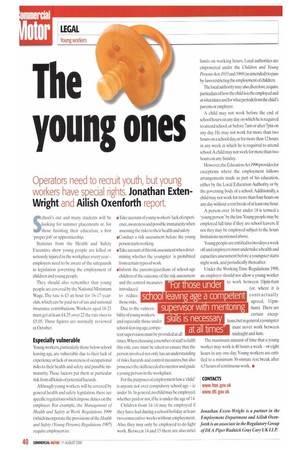The young ones
Page 40

If you've noticed an error in this article please click here to report it so we can fix it.
Operators need to recruit youth, but young workers have special rights Jonathan Exten
Wright and Ailish Oxenforth report.
School's out and many students will be looking for summer placements or, for those finishing their education, a first 'proper job' or apprenticeship.
Statistics from the Health and Safety Executive show young people are killed or seriously injured in the workplace every yearemployers need to be aware of the safeguards in legislation governing the employment of children and young people.
They should also remember that young people are covered by the National Minimum Wage. The rate is £3 an hour for 1617-yearolds, which can he paid net of tax and national insurance contributions. Workers aged 18-21 must get at least £4.25; over 22 the rate rises to 0.05. These figures are normally reviewed in October.
Especially vulnerable
Young workers, particularly those below school leaving age, are vulnerable due to their lack of experience or lack of awareness of occupational risks to their health and safety and possible immaturity. These factors put them at particular risk from all kinds of potential hazards
Although young workers will be covered by general health and safety legislation, there are specific regulations which impose duties on the employer. For example, the Management of Health and Safety at Work Regulations /999 (which incorporate the provisions of the Health and Safety (Young Persons) Regulations 1997) require employers to: *Take account of young workers' lack of experience,awareness and possible immaturity when assessing the risks to their health and safety *Conduct a risk assessment before the young person starts working *Take account of this risk assessment when determining whether the youngster is prohibited from certain types of work *Inform the parents/guardians of school-age
children of the outcome of the risk assessment and the control measures introduced to reduce those risks
Due to the vulnerability of young workers. and especially those under school-leaving age, competent supervision must be provided at all times When choosing a member of staff to fulfil this role, care must be taken to ensure that the person involved not only has an understanding of risks, hazards and control measures, but also possesses the skills needed to mentor and guide a young person in the workplace.
For the purposes of employment law a`child' is anyone not over compulsory school age ie under 16. In general, no child may he employed, whether paid or not, if he is under the age of 14.
Children from 14-16 may be employed if they have had during a school holiday at least two consecutive weeks without employment. Also, they may only be employed to do light work. Between 14 and 15 there are also strict
S i s Is necessary limits on working hours. Local authorities are empowered under the Children and Young PersonsActs 1933 and 1969 (as amended) to pass by-laws restricting the employment of children.
The local authority may also, therefore, require particulars of how the child is to he employed and at what times and forwhat periods from the child's parents or employer.
A child may not work before the end of school hours on any day on which he is required to attend school, or before 7am or after 7pm on any day. He may not work for more than two hours on a school day, or for more than 12 hours in any week in which he is required to attend school.A child may not work for more than two hours on any Sunday.
However,the Education Act 1996 provides for exceptions where the employment follows arrangements made as part of his education, either by the Local Education Authority or by the governing body of a school. Additionally, a child may not work for more than four hours on any day without a rest break of at least one hour.
A person over 16 but under 18 is termed a 'young person' by the law. Young people may be employed full time if they are school leavers If not they may be employed subject to the hours limitations mentioned above.
Young people are entitled to two days a week off and employers must undertake a health and capacities assessment before a youngster starts night work, and periodically thereafter.
Under the Working Time Regulations 1998, an employer should not allow a young worker to work between 10pm-6am (or, where it is contractually agreed, 1 lpm6am). There are certain exceplions, but in general a youngster
supervisor wit mentoring
must never work between midnight and 4am.
The maximum amount of time that a young worker may work is 40 hours a week or eight hours in any one day. Young workers are entitled to a minimum 30-minute rest break after 4.5 hours of continuous work. •


































































































































































































